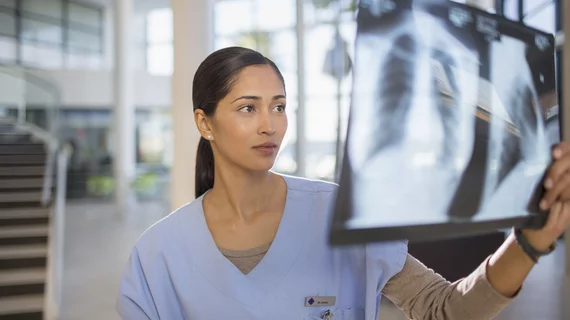ACR pans federal idea to let nonphysicians read X-rays, citing ‘resounding backlash’
The American College of Radiology on Friday announced its opposition to a federal program exploring whether to let nurse practitioners and other nonphysicians read certain X-rays, citing a “resounding backlash.”
The Centers for Disease Control and Prevention first launched its “request for information” related to its “B Reader Program” in December. Participating docs are trained to classify radiographs for the presence and severity of a dust-induced lung disease among workers examined in federal health programs.
However, CDC noted that only 35 states and two territories have trained B Readers, wondering whether NPs and physician assistants could fill the gap. ACR believes the answer is clear.
“There has been a resounding medical community backlash against [the National Institute for Occupational Safety and Health’s request for information], as evidenced by the many comments from individual physicians on the public docket,” CEO Dana H. Smetherman, MD, MBA, MPH, wrote in comments submitted Feb. 27. “The ACR’s official position, as established by the ACR Council, strongly opposes nonphysician involvement in radiology image interpretations.”
ACR—which helped develop the NIOSH exam—refuted notions the current physician B Reader roster is insufficient to meet demand. The college sees other ways to bolster the program such as strengthening financial incentives, extending certification from 5 years to 10, and funding AI tools to aid readers. Smetherman also highlighted the importance of improving outreach to already-certified participants.
The college contends letting NPs and others read these X-rays could pose patient safety issues. ACR received feedback from certified thoracic radiologists, who emphasized identifying interstitial lung disease threshold on chest X-rays is “one of the most challenging tasks they are asked to perform.”
“To be clear, the NIOSH RFI suggests an objectively substandard model of care,” Smetherman wrote. “It is impossible for the agency to mitigate all the risks of nonphysicians providing specialist-level physician services. B reading cannot be safely and effectively incorporated into traditional NP/PA practice models in a manner that provides confidence to public or government stakeholders, and we believe the [Coal Workers’ Health Surveillance Program] would be particularly vulnerable to a resultant decline in quality and consistency.”
In a news update published Friday, ACR said its comments were informed by feedback from B Readers. The college is currently sharing these findings with other medical societies who are considering submitting comments. The CDC is accepting feedback until March 17, having already received over 500 submissions as of Friday. Nurse practitioners have encouraged the agency to consider making the modification.
“The task of applying a prescribed method of determination to an image aligns well within the scope and practice of experienced nurse practitioners in occupational health. I strongly support the change,” Nathaniel D. Collins, a North Carolina-based NP, wrote in December.

